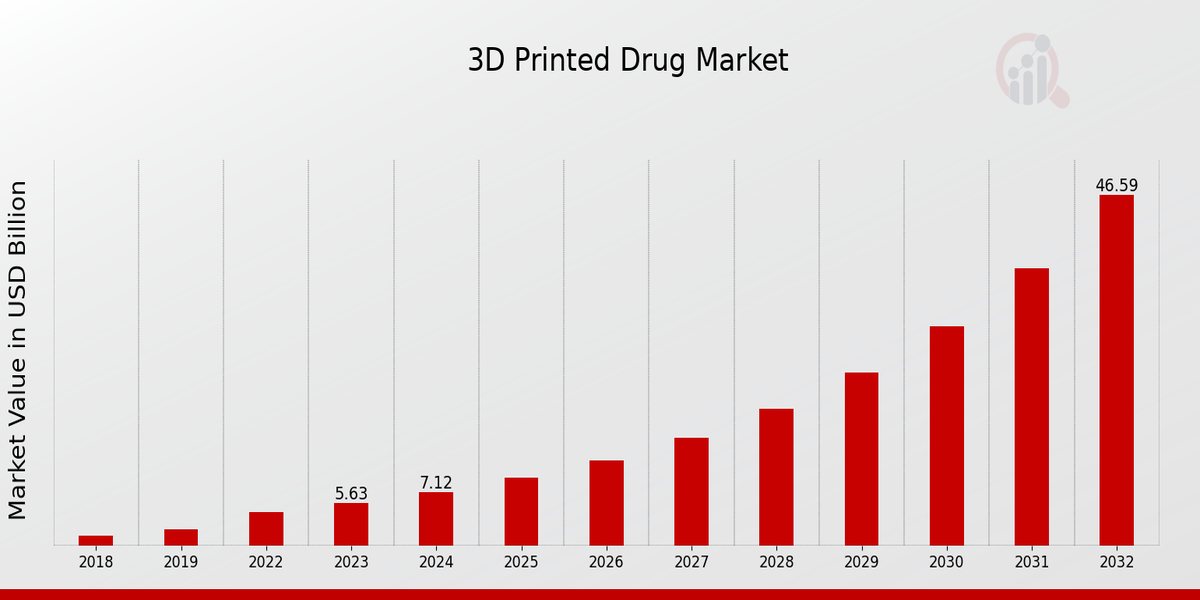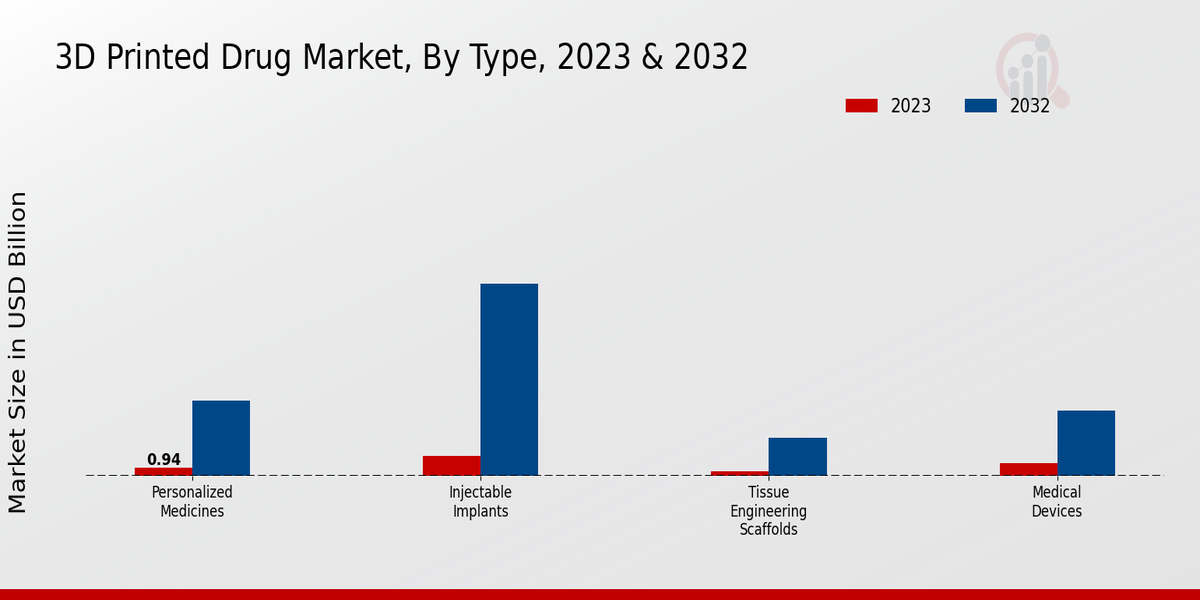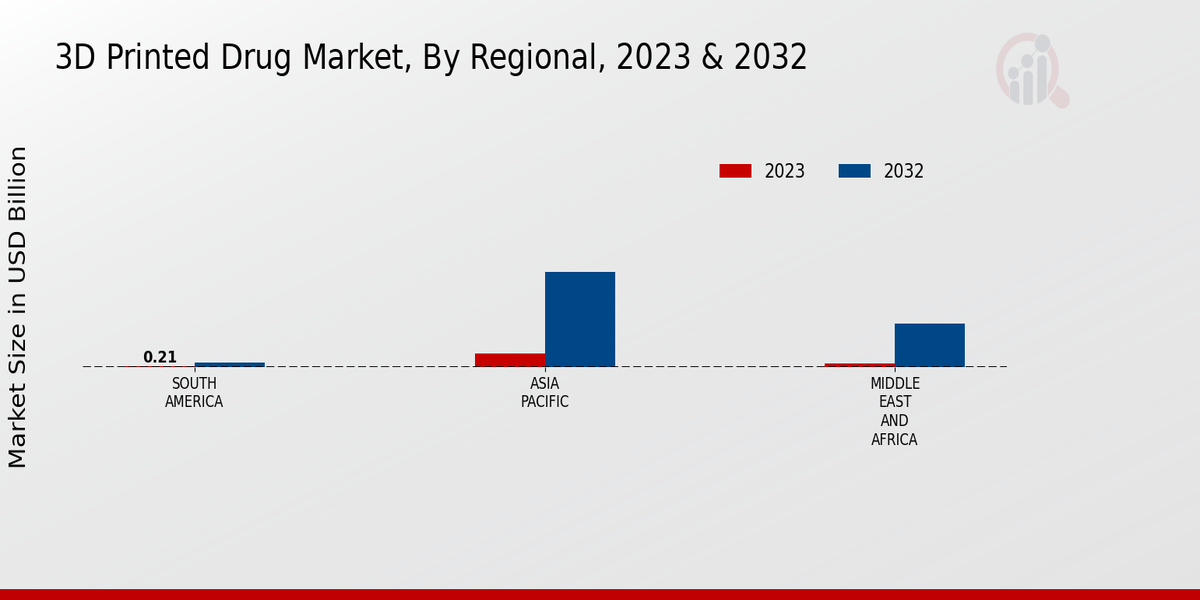3D Printed Drug Market Overview
As per MRFR analysis, the 3D Printed Drugs Market Size was estimated at 56.23 (USD Billion) in 2023.
The 3D Printed Drugs Market is expected to grow from 64.48 (USD Billion) in 2024 to 205.78 (USD Billion) by 2032. The 3D Printed Drugs Market CAGR (growth rate) is expected to be around 15.61% during the forecast period (2024 - 2032).
Key 3D Printed Drug Market Trends Highlighted
The 3D printed drug market is projected to grow significantly in the coming years, driven by the increasing demand for personalized medicine, the rising prevalence of chronic diseases, and advancements in 3D printing technology. Opportunities abound in this market, including the ability to develop patient-specific drugs that are tailored to individual needs, the reduction of drug development time and costs, and the expansion of the market to underserved areas.
In recent times, trends in the 3D printed drug market have included the development of new materials and techniques for printing drugs, the integration of 3D printing with other technologies such as AI and machine learning, and the establishment of partnerships between pharmaceutical companies and 3D printing manufacturers.

Source: Primary Research, Secondary Research, Market Research Future Database and Analyst Review
3D Printed Drug Market Drivers
Advancements in 3D Printing Technology
The 3D printing technology is rapidly evolving, with new advancements being made all the time. These advancements are making it possible to create more complex and precise 3D-printed drugs, which can be used to treat a wider range of diseases and conditions. For example, researchers are now developing 3D-printed drugs that can be used to deliver drugs directly to tumors, reducing the risk of side effects. This technology's continued development is expected to drive the growth of the Global 3D Printed Drug Market Industry in the coming years.
Increasing Demand for Personalized Medicine
The demand for personalized medicine is increasing due to the growing awareness of patients about the benefits of treatments designed specifically for them. 3D printable drugs can be personalized according to each patient’s needs, and such treatments are often more effective and cause fewer side effects. In the years to come, the Global 3D Printed Drug Market Industry is expected to be fueled by the increased number of patients who want their treatment to be more effective and convenient.
Government Support and Funding
Another key driver of the Growth of the Global 3D Printed Drug Market Industry is the support of the government and the funding. Governments all across the globe are providing funding to research and develop 3D-printed drugs. They are providing good support and funding programs to encourage the development of the 3D-printed industry. This is expected to drive the market in the coming years.
3D Printed Drug Market Segment Insights
3D Printed Drug Market Type Insights
The Type segment of the Global 3D Printed Drug Market is segmented into Personalized Medicines, Injectable Implants, Tissue Engineering Scaffolds, and Medical Devices. The Personalized Medicines segment held the largest market share in 2023, and it will continue its dominance during the projected period, ascribed to the growing demand for personalized and target-oriented drug therapy. Injectable Implants will be one of the lucrative market segments in the coming years, propelled by the increasing adoption of minimally invasive procedures and the increasing number of chronic diseases.
Tissue Engineering Scaffolds have attracted much attention in the recent past, leading to promising future market growth with the ability to regenerate damaged tissues and organs. Medical Devices, such as 3D-printed prosthetics and surgical instruments, will be a significant contributor to the overall market revenue in the coming years. The Global 3D Printed Drug Market will witness extensive lucrative growth in the years to come, attributable to the rapid advancements in the technology industry, the rise in healthcare expenditure, and the growing demand for personalized drug delivery systems.

Source: Primary Research, Secondary Research, Market Research Future Database and Analyst Review
3D Printed Drug Market Technology Insights
3D printing technologies play a pivotal role in shaping the Global 3D Printed Drug Market, with each offering distinct advantages. Fused Deposition Modeling (FDM), known for its affordability and versatility, emerged as the dominant technology, accounting for a significant share of the market in 2023. Stereolithography (SLA), renowned for its high precision and surface finish, caters to applications demanding intricate geometries. Selective Laser Sintering (SLS), with its ability to produce complex parts directly from powder, finds applications in the prototyping and manufacturing of drug delivery devices.
Inkjet Printing, leveraging its non-contact deposition process, enables precise placement of drug materials, opening up possibilities for personalized drug development. The Global 3D Printed Drug Market is projected to witness substantial growth in the coming years, driven by technological advancements and increasing adoption in the pharmaceutical industry.
3D Printed Drug Market Application Insights
The Global 3D Printed Drug Market is segmented into various applications such as Cancer Treatment, Orthopedic Implants, Drug Delivery, Tissue and Organ Regeneration, and others. Among these, Cancer Treatment is expected to hold the largest market share in 2023, owing to the increasing prevalence of cancer worldwide and the growing demand for personalized and targeted drug delivery methods. The Orthopedic Implants segment is also expected to witness significant growth due to the increasing demand for patient-specific implants and the rising number of orthopedic surgeries.
The Drug Delivery segment is projected to grow at a steady pace, driven by the advancements in 3D printing technology and the development of novel drug delivery systems. The Tissue and Organ Regeneration segment is expected to gain traction in the coming years, as 3D printing offers the potential to create complex and functional tissues and organs for transplantation.
3D Printed Drug Market End User Insights
The End User segment of the Global 3D Printed Drug Market can be divided into Pharmaceutical and Biotechnology Companies, Hospitals and Clinics, Research Institutions, and Government Agencies. Pharmaceutical and Biotechnology Companies accounted for the largest share in 2023, owing to their significant investments in research and development of 3D printed drugs. Hospitals and Clinics are expected to witness the highest growth rate during the forecast period due to the increasing adoption of 3D printing technology for personalized drug delivery.
Research Institutions are also playing a vital role in advancing the field of 3D-printed drugs, with a focus on developing new materials and applications. Government Agencies are supporting the growth of the industry through funding and regulatory initiatives, such as the development of standards and guidelines for the production and use of 3D-printed drugs.
3D Printed Drug Market Material Insights
The Global 3D Printed Drug Market segmentation by Material includes Polymers, Metals, Ceramics, and Biomaterials. Among these, the polymer segment held the largest market share of around 40% in 2023 and is projected to maintain its dominance during the forecast period. The growth of the polymer segment can be attributed to the increasing adoption of 3D printing technology in the pharmaceutical industry, coupled with the advantages offered by polymers, such as biocompatibility, flexibility, and low cost.
For instance, 3D-printed polymers have been used to develop drug delivery systems that can control the release of drugs over a sustained period, improving patient compliance and reducing side effects.
3D Printed Drug Market Regional Insights
Regionally, North America held the largest market share in 2023, accounting for 35%. Europe followed with a share of 30%, while APAC held a share of 25%. South America and MEA held the remaining shares of 10% and 5%, respectively. The growth of the regional markets is driven by factors such as the rising prevalence of chronic diseases, increasing healthcare expenditure, and the growing adoption of 3D printing technology in the pharmaceutical industry.
North America and Europe are expected to continue to dominate the market due to the presence of well-established healthcare systems, high per capita income, and favorable government initiatives. APAC is expected to witness significant growth due to the increasing demand for personalized medicines and the growing adoption of 3D printing technology in the region. South America and MEA are expected to grow at a steady pace due to the rising investment in healthcare infrastructure and the growing awareness of 3D-printed drugs.

Source: Primary Research, Secondary Research, Market Research Future Database and Analyst Review
3D Printed Drug Market Key Players And Competitive Insights
Major players in 3D Printed Drug Market are continuously focusing on innovative product developments to expand their market share and cater to unmet customer needs. The 3D Printed Drug Market industry has been witnessing a surge in mergers and acquisitions as well as strategic partnerships, as companies strive to strengthen their market position and gain a competitive edge. The Leading 3D Printed Drug Market players are actively engaged in research and development activities to introduce new and improved 3D printing technologies and materials.
These players are also investing in expanding their production capacities to meet the growing demand for 3D-printed drugs. The 3D Printed Drug Market development is being driven by the increasing adoption of personalized medicine, which allows for the creation of custom-made drugs tailored to individual patients' needs. This, in turn, is fueling the growth of the 3D Printed Drug Market Competitive Landscape.
3D Systems is a leading company in the 3D Printed Drug Market and has been at the forefront of developing innovative 3D printing solutions for the healthcare industry.
The company offers a range of 3D printers, materials, and software specifically designed for the production of 3D-printed drugs. 3D Systems has partnered with several pharmaceutical companies to develop and commercialize 3D-printed drugs, including Aprecia Pharmaceuticals and Janssen Pharmaceuticals. Stratasys is a major player in the 3D Printed Drug Market and offers a comprehensive portfolio of 3D printing technologies and solutions for various industries, including healthcare. The company's offerings include 3D printers, materials, software, and services specifically tailored to the needs of the pharmaceutical industry.
Stratasys has collaborated with leading pharmaceutical companies to develop and manufacture 3D-printed drugs, including Merck and Pfizer.
Key Companies in the 3D Printed Drug Market Include
3D Printed Drugs Industry Developments
-
Q2 2025: Entering New Domains for 3D Printing of Drug Products A new regulation coming into effect in summer 2025 in the UK will allow 3D printing of drug products under a distributed manufacturing framework, expanding the legal scope for 3D-printed pharmaceuticals beyond current compounding regulations.
3D Printed Drug Market Segmentation Insights
-
3D Printed Drug Market Type Outlook
- Tissue Engineering Scaffolds
-
3D Printed Drug Market Technology Outlook
- Fused Deposition Modeling
- Selective Laser Sintering
-
3D Printed Drug Market Application Outlook
- Tissue and Organ Regeneration
-
3D Printed Drug Market End User Outlook
- Pharmaceutical and Biotechnology Companies
-
3D Printed Drug Market Material Outlook
-
3D Printed Drug Market Regional Outlook
|
Report Attribute/Metric
|
Details
|
|
Market Size 2023
|
56.23 (USD Billion)
|
|
Market Size 2024
|
64.48 (USD Billion)
|
|
Market Size 2032
|
205.78 (USD Billion)
|
|
Compound Annual Growth Rate (CAGR)
|
15.61% (2024 - 2032)
|
|
Report Coverage
|
Revenue Forecast, Competitive Landscape, Growth Factors, and Trends
|
|
Base Year
|
2023
|
|
Market Forecast Period
|
2024 - 2032
|
|
Historical Data
|
2019 - 2023
|
|
Market Forecast Units
|
USD Billion
|
|
Key Companies Profiled
|
Innoforce, Stratasys, Photocentric, voxeljet, Prodways Group, EnvisionTEC, SLM Solutions Group AG, Arcam, Renishaw, ExOne, 3D Systems Corporation, Optomec, Organovo, XJET
|
|
Segments Covered
|
Type, Technology, Application, End User, Material, Regional
|
|
Key Market Opportunities
|
Personalized medicine Advanced drug delivery systems Complex drug formulations Pointofcare manufacturing Reduced drug development costs
|
|
Key Market Dynamics
|
Rising demand for personalized medicine Technological advancements Increasing prevalence of chronic diseases Government initiatives and funding Growing focus on drug safety and efficacy
|
|
Countries Covered
|
North America, Europe, APAC, South America, MEA
|
Frequently Asked Questions (FAQ):
The global 3D-printed drug market is expected to reach USD 64.48 billion in 2024.
The global 3D printed drug market is projected to reach USD 205.78 billion by 2032, exhibiting a CAGR of 15.61% from 2024 to 2032.
North America is expected to dominate the global 3D printed drug market throughout the forecast period, owing to the presence of major pharmaceutical companies and research institutions, as well as favorable government regulations.
Key applications of 3D-printed drugs include personalized drug delivery, drug discovery and development, and tissue engineering.
Key competitors in the global 3D printed drug market include Aprecia Pharmaceuticals, Aprecia Pharmaceuticals, Inc., 3D Systems Corporation, FabRx, Inc., and Stratasys Ltd.
Major factors driving the growth of the global 3D printed drug market include the increasing demand for personalized medicine, the need for improved drug delivery systems, and the technological advancements in 3D printing.
Challenges faced by the global 3D printed drug market include the high cost of 3D printing equipment, the need for regulatory approval for 3D printed drugs, and the lack of skilled professionals in 3D printing.
Opportunities for the global 3D printed drug market include the development of new 3D printing technologies, the expansion of 3D printing applications in healthcare, and the increasing investment in 3D printing research and development.
Key trends in the global 3D printed drug market include the increasing use of 3D printing for drug discovery and development, the development of new 3D printing materials, and the integration of 3D printing with other technologies such as artificial intelligence and machine learning.
The future outlook for the global 3D printed drug market is positive, with the market expected to continue to grow rapidly in the coming years. This growth is expected to be driven by the increasing demand for personalized medicine, the need for improved drug delivery systems, and the technological advancements in 3D printing.

















